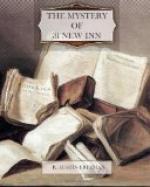I stared at Thorndyke in amazement.
“Do you mean to tell me,” I exclaimed, “that that photograph is really upside down?”
“I do indeed,” he replied.
“But how do you know? Have we here yet another Oriental scholar?”
Thorndyke chuckled. “Some fool,” he replied, “has said that ’a little knowledge is a dangerous thing.’ Compared with much knowledge, it may be; but it is a vast deal better than no knowledge. Here is a case in point. I have read with very keen interest the wonderful history of the decipherment of the cuneiform writing, and I happen to recollect one or two of the main facts that seemed to me to be worth remembering. This particular inscription is in the Persian cuneiform, a much more simple and open form of the script than the Babylonian or Assyrian; in fact, I suspect that this is the famous inscription from the gateway at Persepolis—the first to be deciphered; which would account for its presence here in a frame. Now this script consists, as you see, of two kinds of characters; the small, solid, acutely pointed characters which are known as wedges, and the larger, more obtuse characters, somewhat like our government broad arrows, and called arrow-heads. The names are rather unfortunate, as both forms are wedge-like and both resemble arrow-heads. The script reads from left to right, like our own writing, and unlike that of the Semitic peoples and the primitive Greeks; and the rule for the placing of the characters is that all the ‘wedges’ point to the right or downwards and the arrow-head forms are open towards the right. But if you look at this photograph you will see that all the wedges point upwards to the left and that the arrow-head characters are open towards the left. Obviously the photograph is upside down.”
“But,” I exclaimed, “this is really most mysterious. What do you suppose can be the explanation?”
“I think,” replied Thorndyke, “that we may perhaps get a suggestion from the back of the frame. Let us see.”
He disengaged the frame from the two nails on which it hung, and, turning it round, glanced at the back; which he then presented for my inspection. A label on the backing paper bore the words, “J. Budge, Frame-maker and Gilder, 16, Gt. Anne Street, W.C.”
“Well?” I said, when I had read the label without gathering from it anything fresh.
“The label, you observe, is the right way up as it hangs on the wall.”
“So it is,” I rejoined hastily, a little annoyed that I had not been quicker to observe so obvious a fact. “I see your point. You mean that the frame-maker hung the thing upside down and Jeffrey never noticed the mistake?”
“That is a perfectly sound explanation,” said Thorndyke. “But I think there is something more. You will notice that the label is an old one; it must have been on some years, to judge by its dingy appearance, whereas the two mirror-plates look to me comparatively new. But we can soon put that matter to the test, for the label was evidently stuck on when the frame was new, and if the plates were screwed on at the same time, the wood that they cover will be clean and new-looking.”




